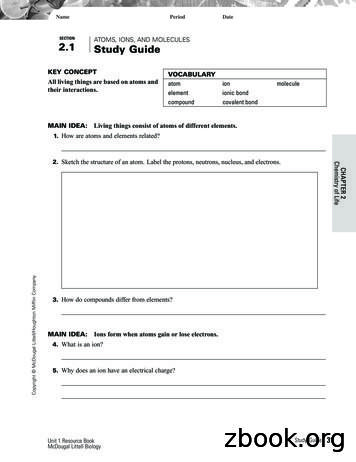2.3 Carbon-Based Molecules
2.3 Carbon-Based MoleculesKEY CONCEPTCarbon-based macromolecules are the foundationof life.
2.3 Carbon-Based Molecules! Carbon atoms have unique bonding properties. Carbon forms covalent bonds with up to four other atoms,including other carbon atoms. Carbon-based molecules have three general types ofstructures.1. straight chain2. branched chain3. ring
2.3 Carbon-Based Molecules Many carbon-based molecules are made of many smallsubunits bonded together.– Monomers are the individual subunits.– Polymers are made of many monomers that arebonded together.
2.3 Carbon-Based Molecules! Four main types of carbon-based macromolecules arefound in living things:1) Carbohydrates are made of carbon, hydrogen, andoxygen.
2.3 Carbon-Based Molecules EXAMPLES OF CARBOHYDRATES:– Carbohydrates includesugars and starches.– Monosaccharides aresimple sugars like glucose.– Polysaccharides aremonosaccharides that arelinked together and includestarches, cellulose, andglycogen.
2.3 Carbon-Based Molecules Carbohydrates can be broken down to provideenergy for cells. Some carbohydrates are part of cell structure.Polymer (starch)Polymer (cellulose)monomerStarch is a polymer ofglucose monomers thatoften has a branchedstructure.Cellulose is a polymer ofglucose monomers thathas a straight, rigidstructure
2.3 Carbon-Based Molecules2) Lipids are nonpolar molecules that include fats, oils, andcholesterol.– Many contain carbon chains called fatty acids.– Fats and oils contain fatty acids bonded to glycerol.Triglyceride
2.3 Carbon-Based Molecules Lipids have several different functions.– broken down as a source of energy– make up cell membranes– used to make hormones
2.3 Carbon-Based Molecules Fats and oils have different types of fatty acids.– saturated fatty acids– unsaturated fatty acids
2.3 Carbon-Based Molecules Phospholipids make up all cell membranes.– Polar phosphate “head” (hydrophilic)– Nonpolar fatty acid “tails” (hydrophobic)Phospholipid
2.3 Carbon-Based Molecules3) Proteins are polymers of amino acid monomers.– Twenty different amino acids are used to build proteinsin organisms.
2.3 Carbon-Based Molecules Amino acids are monomers of proteins.– Amino acids differ in side groups, or R groups.– Amino acids have an amine group (NH2) and a carboxylgroup (COOH)aminecarboxyl
2.3 Carbon-Based Molecules– Amino acids are linked by peptide bonds.
2.3 Carbon-Based Molecules Proteins differ in the number and order of amino acids.– Amino acids interact to give a protein its shape.Hemoglobinhydrogen bond– Incorrect amino acids change a proteinʼs shapewhich changes the way it works.
2.3 Carbon-Based Molecules4) Nucleic acids are polymers of monomers callednucleotides.
2.3 Carbon-Based Molecules Nucleotide monomers make up nucleic acids.– Nucleotides are made of a sugar, phosphategroup, and a nitrogen base.A phosphate groupdeoxyribose (sugar)nitrogen-containing molecule,called a base
2.3 Carbon-Based MoleculesEXAMPLES OFNUCLEIC ACIDS:DNA– DNA, deoxyribonucleicacid, stores geneticinformation.– RNA helps createnew proteins.RNA
Carbon forms covalent bonds with up to four other atoms, including other carbon atoms. Carbon-based molecules have three general types of structures. 1. straight chain 2. branched chain 3. ring . 2.3 Carbon-Based Molecules Many carbon-based molec
CARBON-BASED MOLECULES Reinforcement KEY CONCEPT Carbon-based molecules are the foundation of life. Carbon atoms are the basis of most molecules that make up living things. Many carbon-based molecules are large molecules called polymers that are made of many smaller, repeating molecules called monomers. There are four main types of
Answer: Carbon is versatile Can form many covalent bonds resulting in molecules with complex structures (chains, rings, branching) C C C C Organic: Molecules with a carbon skeleton Inorganic: Molecules without a carbon skeleton Functional Groups: Determine characteristics of molecules
The molecules in water have a small positive and a small negative charge, a bit like the poles on a magnet. We call such molecules with partial charges polar molecules. The molecules in oil have almost no positive or negative charge. We call these molecules non-polar molecules. Different kinds of molecules do not mix well with each other. Polar
Page 1 of 12 NAME: SCHOOL: TEACHER: BASIC ORGANIC MOLECULES: WORKSHEET 1 BACKGROUND INFORMATION CONCEPTS Organic molecules as molecules containing carbon atoms. Hydrocarbons are organic compounds that consist of hydrogen and carbon only Homologous series: A series of organic compounds that can be described by the same general formula and where each member differs from the
a. nitrogen. c. water. b. carbon dioxide. d. oxygen. ANS: D DIF: 1 OBJ: 6-1.3 21. During the Calvin cycle, carbon-containing molecules are produced from a. carbon atoms from ATP. b. carbon atoms, hydrogen atoms, and oxygen atoms from glucose. c. carbon atoms from carbon dioxide in the air and hydrogen atoms from water.
9 Which property allows carbon to form a variety of long-chain polymers? A. Carbon has six valence electrons used in multiple bonds. B. Carbon forms strong ionic bonds with different molecules. C. Carbon has four valence electrons, allowing for multiple bonds. D. Carbon forms both ionic and covalent bonds with other carbon atoms.
4 Binding Forces Between Molecules For molecules to exist as aggregates in gases, liquids, and solids, intermolecular forces must exist. Intermolecular forces Cohesion, or the attraction of like molecules, Adhesion, or the attraction of unlike molecules, Repulsion is a reaction between two molecules that forces th
8 DNA, genes, and protein synthesis Exam-style questions. AQA Biology . ii. Suggest why high humidity is used in theinvestigation. (1 mark) b . The larva eats voraciously but the pupa does not feed. The cells inside the pupa start to break down the larval tissues and form the adult tissues. The larval tissue and adult tissue contain different proteins. The genes in the cells of the larva are .























